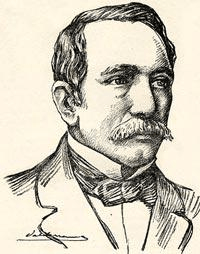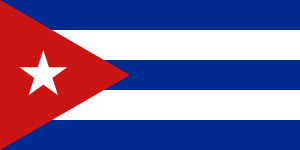Narciso López facts for kids
Quick facts for kids
Narciso López
|
|
|---|---|
 |
|
| Birth name | Narciso López de Urriola |
| Born | November 2, 1797 Caracas, Venezuela |
| Died | September 1, 1851 (aged 53) Havana, Cuba |
| Allegiance | |
| Service/ |
Spanish Army |
| Rank | General |
| Battles/wars |
|
Narciso López was a general and adventurer born in Venezuela. He lived from November 2, 1797, to September 1, 1851. He is best known for trying to free Cuba from Spanish rule in the 1850s. His soldiers carried a special flag that López himself designed. This flag later became the official flag of Cuba. After his last attempt to free Cuba failed, he was captured and put to death in Havana.
Contents
A Life of Adventure and Change
Narciso López was born in Caracas, Venezuela. His family was wealthy and came from the Basque region. When he was a young teenager in 1814, he was forced to join the Spanish army. This happened during a time when Venezuela was fighting for its independence.
López fought for Spain against the independence forces. He took part in important battles like the Battle of Queseras del Medio in 1819 and Carabobo in 1821. These battles were against famous leaders like Simón Bolívar.
After Spain lost the Battle of Lake Maracaibo in 1823, López left Venezuela with the defeated Spanish army. He moved to Cuba. In 1825, he married María Dolores, whose brother was a count in Cuba. López had already become a colonel in the Spanish Army at age 31.
He later fought in the First Carlist War in Spain. After this war, López worked for the Spanish government in different jobs. He even served as a military governor in Madrid. López then moved back to Cuba to work for the new captain general. However, he lost his job when the leadership changed in 1843. After some failed business attempts, he started to support the group in Cuba that wanted to break away from Spain. In 1848, when Spanish authorities arrested Cuban revolutionaries, López escaped to the United States.
Planning to Free Cuba
Once in the United States, López started planning a "filibustering" expedition. A filibuster was a private military action by a group of people who wanted to overthrow a government. López wanted to free Cuba from Spain. He talked to important American politicians, like John L. O'Sullivan. O'Sullivan was known for the idea of "Manifest Destiny," which was the belief that the United States was meant to expand across North America.
López gathered Cuban exiles in New York City and other adventurers. In 1849, his first expedition was ready. About 600 volunteers gathered on Round Island, Mississippi. They had three ships ready to take them to Cuba. However, the US President at the time, Zachary Taylor, did not support these private military actions. He ordered the ships to be stopped and seized. By September 9, the volunteers had to leave Round Island.
López and many of his leaders were Freemasons. They used their connections within this group to help with their plans.
Attempts to Invade Cuba
Even after this setback, López did not give up. He decided to plan another expedition. This time, he focused on getting support from the Southern United States. López supported slavery, and he thought an independent Cuba would be a strong partner for the Southern states. Some Southerners even hoped Cuba might join the US as a slave state, like Texas had.
López moved his base to New Orleans. He tried to get famous Southern men to join his cause. He asked Senator Jefferson Davis for military help. Davis was a hero from the Mexican–American War. López offered him a lot of money and a coffee plantation. Davis said no but suggested his friend, Major Robert E. Lee. Lee thought about the offer but also decided not to join.
Even though he couldn't get these famous generals, López gained support from many other powerful Southerners. These included Governor John A. Quitman of Mississippi. López gathered about 600 fighters for his expedition. In May 1850, they successfully reached Cuba. His troops took over the town of Cárdenas. They carried the flag that López and Miguel Teurbe Tolón had designed, which is now the flag of Cuba.
However, the local people in Cuba did not join López as he had hoped. Many locals actually fought against him with the Spanish forces. López quickly retreated to Key West, Florida. There, he broke up his expedition to avoid being arrested by the US government.
After this expedition, López and many of his supporters were investigated. While they were not convicted, Governor John Quitman had to resign. Despite these problems, López started planning yet another expedition.
In August 1851, López sailed for Cuba again with hundreds of men. Most of them were Americans, Hungarians, Germans, and some Cubans. When they arrived, López took half his group to march inland. The other half stayed on the coast to protect supplies. Again, the local support López expected did not happen. López and many of his men were surrounded and captured by Spanish forces. The other group also faced the same fate. The Spanish executed most of the captured fighters.
Among those executed were many Americans, including Colonel William Crittenden. Narciso López himself was executed in Castle La Punta in Havana.
What Happened Next
The execution of López and his soldiers made many people angry in both the Northern and Southern United States. Even those who didn't support López's expeditions thought the Spanish treatment of the prisoners was cruel. The strongest reaction was in New Orleans, where a crowd attacked the Spanish consulate.
Even though López's expeditions failed, they inspired other "filibusters" to try similar actions across Latin America in the 1850s. A famous example is William Walker's invasions of Nicaragua. If López had succeeded, he could have greatly changed politics in the Americas. He might have given the United States a strong presence in the Caribbean and encouraged more expansion.
Instead, the failure of López and other filibusters discouraged Americans, especially in the South, from trying to expand further. Since slavery could not easily expand southward, many Southerners started talking about leaving the United States. This eventually led to the American Civil War.
Today, the flag of Cuba is based on the flag López used in his expeditions.
See also
 In Spanish: Narciso López para niños
In Spanish: Narciso López para niños
- History of Cuba
- History of the United States (1849–1865)
- Bay of Pigs Invasion
- Cuba–United States relations
- Cuba–Venezuela relations


